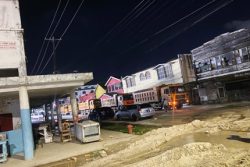The Linden-Lethem trail is to be transformed into an all-weather road with Brazilian help if the plans of the Ministry of Public Works are realized. The ministry is expecting that the first stage will be accomplished in the coming weeks when the terms of reference for Brazil to fund a detailed engineering design for the road will be finalized.
While nearly $250M has been allocated in this year’s budget for continued works on the Linden to Lethem trail, the financial input from Guyana’s Portuguese neighbour was needed, said engineers from the Ministry of Public Works, to effect the transformation of the trail into the all-weather roadway necessary for trade and other benefits.
“The monies allocated [in the budget] will go towards continued maintenance … grading, fixing eroded sections and so forth, but very soon we should have the terms of reference for a detailed engineering design that will see us getting an all-weather road,” Chief Transport Officer of the Ministry of Public Works (MPW) Patrick Thompson told Stabroek News.
Thompson, Rabindranauth Chanderpaul, the MPW’s Technical Services Manger and its Hinterland Engineer Naeem Chanderpaul sat down with Stabroek News in an interview recently to discuss the project.
Government this year proposed $1B for the development of hinterland roads, and of that sum nearly $250M has been allocated to the Linden-Lethem road. The Public Works Hinterland Engineer informed this newspaper that the road was divided into three lots, for which different sums – $70M, $64, and $115M – out of the total had been earmarked.
The first section sees works from Linden to the Omai Turn-Off being undertaken, involving grading, shaping and the addition of lateritic material to the road. A part of this section is maintained by Demerara Timbers Ltd which is why the money allocated is less than for the other two segments.
Lot 2 is from Mile 84 to Kurupukari and includes the mirror clearing of trees. The last section runs from Kurupukari to Lethem and this project includes clearing some 50miles on both sides within the Iwokrama concession. This, the engineer explained, was needed so that the moisture settled on the forest floor did not drain to the road and possibly cause erosion.
He said that the works being done were to not only improve the infrastructure and safety of the road, but to reduce travel time.
Currently the travel time from Georgetown to Lethem is approximately 15 hours by bus. About 13½ hours of this is accounted for on the Linden to Lethem stretch, while Georgetown to Linden takes 90 minutes.
The Ministry of Public Works is hoping that this time can be cut by some five hours following the improvements.
At a press conference last month Minister of Foreign Affairs Caroline Rodrigues-Birkett had told reporters that a joint venture between Guyana and Brazil would see studies being undertaken, beginning this month, to determine the possibility of developing two hydropower sites in the Middle and Upper Mazaruni, Region 7. This, she had said, was linked to Brazil’s input into construction of the road. “The two are very much connected and we have decided that the hydro and the road should move together… The road will cost a handsome sum and at this point we are not able to increase our debt. The idea is that if the projects prove feasible there is that agreement for Brazil to purchase the energy and then we can frontload and start the road. We will be able to get our road, sell some energy and get some revenue,” she had stated.
Minister of Finance Dr Ashni Singh also said during this year’s budget reading that negotiations had advanced substantially between the two countries and technical working groups were preparing the design study for the construction of the Linden to Lethem road.
Stabroek News understands that the design for the road will cost over $2B but that in addition to the design funds, talks were also ongoing on funding for construction.
The Ministry of Public Works engineer pointed out that Brazil was open to the project because of the benefit to northern Brazil, especially the states of Roraima and Amazonia as these are likely to take advantage of port Guyana in trade.
Although environmental and social impact assessments were done many years ago these will need to be updated because there have been many changes in both areas.
The terms of reference come only now, Thompson explained, because “It’s not a straightforward and simple process given that the issue of foreign affairs, immigration and Amerindian protected lands will all be tied into it.”
The engineer outlined some of the benefits: “…fundamental to economic development is the injection of money into the community. Road infrastructure programmes have such an opportunity to impart skills and income to the resident population…
“Improved infrastructure in general will enhance the social standard of the population in and around the area. Additional employment opportunities will give a social improvement in the same population through increased economic growth, which in turn will lead to improved standards of living…it will increase the security and provide services in the daily lives of the adjacent population,” he said .
Thompson listed the positive economic benefits as including the improved availability of agricultural inputs and wholesale supplies of retail goods for small businesses. With a general increase in the population’s spending power, demand would increase for such items, businesses would grow, and new opportunities develop. The non-farm economic sector is expected to develop the most.






